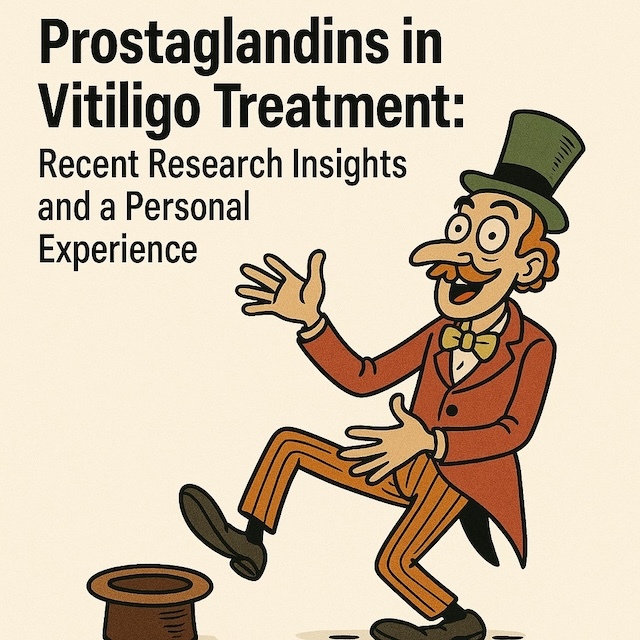New
When My Knees Got Weird: A Personal Glitch in Prostaglandin Therapy for Vitiligo
Three weeks into my vitiligo treatment, my knees started feeling weirdly loose. No pain, just… unnerving wobbling. That wasn’t in any of the studies I’d read.
Let me back up and explain what led me here — and why this side effect might not be so random after all.
The Science Behind the Hype
If you follow vitiligo research, you’ve probably seen the buzz around prostaglandins, especially PGE2. These are lipid-based compounds that influence inflammation, immune response, and — as it turns out — pigmentation.
A 2024 review of 42 studies (1,000+ patients) showed prostaglandin analogues (PGAs) can help kickstart melanocytes and calm autoimmune attacks. They work well alone, and even better when paired with UVB, lasers, or microneedling.
One 2023 trial compared PGE2 to PGF2α. Both helped more than 90% of treated areas regain color, but PGE2 worked faster and made patients happier overall. That’s the kind of win clinicians love.
Side effects? According to the literature, mostly mild and local — things like redness or a short-lived burning feeling. No one’s reporting joint weirdness.
The Good Part: Early Wins
Guided by my dermatologist, I applied topical PGE2 to vitiligo patches on the face, neck and hands. It was off-label — meaning not yet formally approved for vitiligo — but based on sound logic and growing evidence. Within a few weeks, I saw signs of repigmentation on the face — just like described in the studies.
It was exciting. It felt like progress. Until it didn’t.
The Plot Twist: Hypermobile Joints?
Around week three, I noticed my joints — especially my knees — had become oddly flexible. Not injured, just… off. As if the supportive structures were suddenly too relaxed.
It was enough to raise an eyebrow — and then both eyebrows. I stopped the treatment cold. Thankfully, my knees returned after a week.
Could It Be the Cream?
At first, I thought it was coincidence. But I dug deeper. Turns out, there’s some science that might explain what happened.
PGE2 doesn’t just affect pigment cells. It also plays a role in collagen regulation. Studies in tendon fibroblasts show PGE2 can reduce collagen production by nearly 50%. Other research in wound healing shows it limits scar formation by preventing excessive matrix buildup.
All of this is great for skin healing. But if that same mechanism hits your joint capsules? You might just end up with ligaments that feel like they’ve been on a yoga retreat.
Why Me?
Any of these sound familiar? If you’ve ever had a medication work differently than expected, you know the drill.
Here’s what might’ve played a role:
- Potency: Some studies use around 250 µg/g of PGE2. I don’t remember the exact strength of mine, but I might’ve gone heavy on the application.
- Area: Most research sticks to under 5% body surface. I didn't cross that limit, but maybe it was large enough for my body.
- Genetics: Some people just absorb topical meds more easily. I might be one of them.
What This Means for Patients and Doctors
Prostaglandins are still promising. But my case shows we need to stay sharp, even with “safe” treatments.
If you’re prescribing or using PGE2 for vitiligo:
- Stick to small areas.
- Use standard concentrations.
- Monitor for strange effects — not just at the skin level.
- Be cautious with prolonged or widespread use.
What This Means for Researchers
This experience flags a few blind spots in the literature:
- How much prostaglandin actually gets absorbed into the system?
- Can it affect connective tissues outside the treatment area?
- Why do some people seem more sensitive than others?
- What happens after longer use? Are there slow-burning effects?
Let’s Keep It Honest
This isn’t an anti-PGE2 rant. It’s a nudge toward nuance.
Most people probably won’t have the same reaction I did. But rare effects often start with one patient raising a hand and saying, “Hey, something strange happened.”
That’s how medical progress happens — not just through big trials, but through honest stories.
If you’ve had a similar experience with prostaglandins — or any vitiligo treatment — I’d love to hear about it. These stories matter.
Note: This is my personal experience, not medical advice. Talk to your doctor before trying any treatment, and speak up if anything feels off.

Yan Valle
Professor h.c., CEO VR Foundation | Author A No-Nonsense Guide To Vitiligo
Keep reading:
- Topical Treatments for Vitiligo: What We Know (and Still Don’t) About Their Safety
- Rethinking Vitiligo – Five Distinct Faces of a Complex Disease
- Biologic Therapies for Vitiligo: A New Era of Hope
or Listen to Deep Dive in Vitiligo podcast
- Biologics, Creams, and the Safety Factor in Vitiligo (Ep. 44)
- Sixty Years Of Vitiligo Research — Where Are We Now and What Comes Next? (Ep. 35)
Our podcast Deep Dive In Vitiligo is available on all digital platforms, like Apple Podcasts, Spotify, Amazon, YouTube Music, Podcast Addict, iHeart and elsewhere.

FAQOther Questions
- Any link between vitiligo and military service?
While there isn't specific research directly linking military service to the onset of vitiligo, it's critical to comprehend that vitiligo is a multifaceted disorder influenced b...
- I have a new job - should I tell colleagues about my vitiligo?
Starting a new job can be both exciting and nerve-wracking—especially if you’re concerned about stares or questions regarding your skin. Taking a proactive approach can help eas...
- Is there a link between vitiligo and depression?
Depression and anxiety are often linked with vitiligo, significantly impacting a person’s quality of life. The connection stems from the shared origin of the skin and brain duri...
Though it is not always easy to treat vitiligo, there is much to be gained by clearly understanding the diagnosis, the future implications, treatment options and their outcomes.
Many people deal with vitiligo while remaining in the public eye, maintaining a positive outlook, and having a successful career.
Copyright (C) Bodolóczki JúliaBy taking a little time to fill in the anonymous questionnaire, you can help researchers better understand and fight vitiligo.
